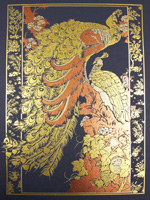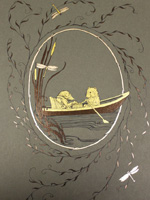The Folio Society
The Folio Society was founded in London in 1947. It was the brainchild of book-lover and collector, Charles Ede, whose desire to combine the typographical and artistic standards of the private presses with the latest industrial technology, resulted in some of the most beautiful and imaginative bindings ever seen.
During WWII strict austerity measures had been placed on book production, leaving Charles increasingly concerned about the decline in standards which might not be easily overturned after the war. He wanted desperately to spread his enthusiasm for books beyond the confines of the small circle of comparatively rich and in doing so, set about outlining his plan, with good friend and Golden Cockerel Press owner, Christopher Sandford, to bring the ‘poor man’s fine edition’ to the masses. He attended the London College of Printing in 1946 and by 1947 had launched the Folio Society, sharing premises with the Golden Cockerel Press in a Dickensian garret in London’s Soho.
Charles planned to publish one book a month, selling through booksellers and trying to establish a feel for demand. There were formidable problems, however, not the least of which was post-war paper rationing. Although Charles qualified, as an ex-serviceman, for a reasonable amount of paper, it was only sufficient for about five books. For the rest he begged and scrounged.
In October 1947, the Society produced its first book: Tales by Tolstoy, with pen and ink illustrations by Elizabeth Facfadyen. George du Maurier’s Trilby followed in November and a translation of Aucassin and Nicolette appeared in December. The editions proved difficult to sell though and for its first three years, the Society’s existence hung in the balance. Determined to generate more interest, the Society launched an advertising campaign in 1949, inviting people to subscribe directly and rewarding them with a presentation volume for becoming members.
The campaign was successful and gradually the Folio Society began to make a name for itself. By the mid-1950s, it had moved to larger quarters, where a spacious garden allowed club room members to enjoy wine and sandwiches. Charles’ main focus, however, was to keep building the library and his enthusiastic involvement with the Society remained undimmed for twenty-four years, by which time he had secured its image and reputation.
By 1971, the Folio Society had grown so large, that Charles, who was known for his involvement in every aspect of production, including choice of titles and supervision of printers and illustrators, could no longer do everything himself. Instead, he turned his attention to antiquities and John Letts and Halfdan Lynner took over the business. Both had backgrounds in publishing and they were keen to establish a clear identity for the Society. Its purpose was not just to be a producer of handsome books but a publisher of new literary discoveries and in the early 1980s one such manuscript crossed their path. Whilst researching his book on the Indian Mutiny, historian Christopher Hibbert discovered the vividly written diary of General Richard Barter of the 75th Gordon Highlanders and the 15th Ludhiana Sikhs. Barter had been on a leisure trip to the hills, when the mutiny broke out and instead found himself marching back towards Delhi. The result, combined with photographs held by Barter’s great-great grandson, was The Siege of Delhi: Mutiny Memories of an Old Officer (1984).
In 1982 the Folio Society changed hands again. Now under Bob Gavron’s chairmanship, it has grown considerably. The classics are still represented but the broader dimensions of publishing and production are now recognised. Fine artists have been commissioned for illustrations and bindings have a flamboyancy worthy of their contents. Indeed, the books are instantly recognisable as “Folio”. No two of them are alike, yet they all share the commonality of quality.






